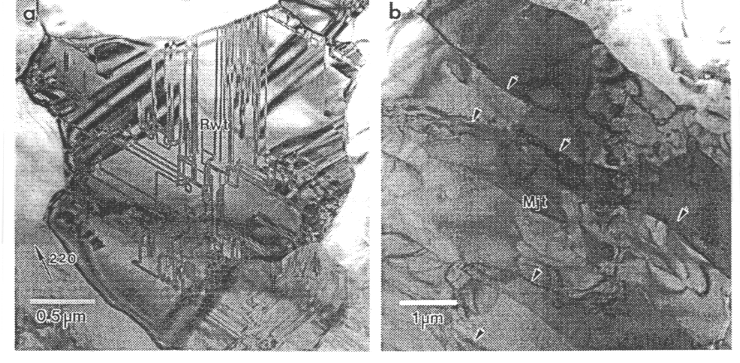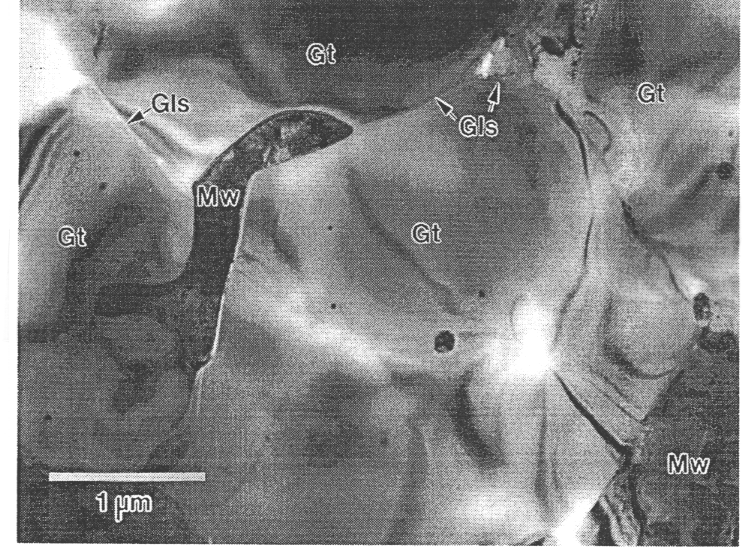

High pressure minerals occur naturally in shocked meteorites as a result of shock metamorphism induced by collisions of planetary bodies during the formation of the solar system. Such samples gave us an insight into the mineralogy of the Earth's mantle and the defect microstructures of high-pressure minerals. Since the development of experimental techniques for the synthesis of high-pressure minerals and the investigation of kinetic processes in these materials, it is now possible to interpret the assemblages and microstructures of high-pressure minerals in shocked meteorites to better understand shock processes. Little is known about the conditions of shock metamorphism because laboratory shock experiments do not produce high-pressure minerals. Based on such experiments however, the duration of these events is believed to be on the order of microseconds. To investigate the conditions and duration of shock metamorphism in chondrites, we are using analytical TEM to characterize the microstructures of high-pressure minerals in the Sixiangkou L6 chondrite.
The shock veins in Sixiangkou contain large polycrystalline grains of
(Mg,Fe)2SiO4-spinel (Ringwoodite) and (Mg,Fe)SiO3-garnet
(majorite), as well as diaplectic (dense) glass and metal-sulfide intergrowths
in a matrix of fine-grained garnet, oxide, sulfide, and metal phases. The
polycrystalline ringwoodite and majorite have exactly the same compositions
as olivine and low-Ca pyroxene outside the shock veins, respectively, and
are therefore interpreted as products of solid-state polymorphic phase
transformations. The grains of ringwoodite and majorite consist of relatively
large crystals (3 to 6 µm and 10 µm, respectively) containing
numerous stacking faults and dislocations (Fig. 3.5-5). The dislocations
in majorite are organized into subgrain boundaries, indicative of deformation
by dislocation creep and climb.
 |
Fig. 3.5-5: Bright-field TEM images of polycrystalline (a) ringwoodite (Rwt) and (b) majorite (Mjt). Polycrystalline ringwoodite consists of crystals that range in size from 3 to 6 µm and have moderate densities of stacking faults. Polycrystalline majorite consists of crystals as large as 10 µm with numerous dislocations which are organized into subgrain boundaries (arrows). |
The fine-grained matrix in the shock veins consists of metal-rich and metal-poor assemblages. The bulk composition of the metal-poor assemblage is nearly identical to that of the bulk meteorite. The primary silicate phase in the metal-poor assemblage is a majorite-pyrope garnet, rich in Cr2O3, CaO and Na2O which is accompanied by magnesiowüstite, magnetite, kamacite, troilite and SiO2-Na2O-rich glass. The garnets are euhedral to subhedral and range from 1 to 4 µm in diameter with irregular grains of magnesiowüstite filling interstitial channels (Fig. 3.5-6). The texture and bulk composition of this material indicate that it crystallized from a melt of bulk Sixiangkou composition under high pressure and temperature conditions. The garnet and magnesiowüstite were liquidus phases with the other minerals and glass representing residual metal-sulfide and silicate melts, respectively.
 |
Fig. 3.5-6: Bright-field TEM image of the matrix material showing euhedral majorite-pyrope garnets (Gt) with irregular grains of magnesiowüstite in between the garnets. A silicate glass (Gls) is present along some grain boundaries and within grain junctions. |
The mineral assemblages and microstructures allow us to constrain, for the first time, the conditions of crystallization and the duration of the shock event. Published liquid-crystal equilibria for chondritic compositions show that the majorite-pyrope garnet plus magnesiowüstite assemblage is stable at pressures and temperatures from 19 to 24 GPa and 1900 to 2100 °C. There are no dendritic or spinifex quench textures that commonly form when mafic melts are rapidly cooled (1 to 2 seconds) which suggests that the timescale of the high-pressure and temperature conditions was much longer than the microsecond timescales deduced from shock experiments. The duration of high P-T conditions was long enough for: i) solid-state transformation of olivine and pyroxene to ringwoodite and majorite polycrystals, ii) dislocation creep and recovery in the majorite polycrystals, iii) melting of the shock vein and partial melting of the polycrystals, and iv) crystallization of the matrix assemblage at high pressure and temperature. Solid-state transformations, dislocation recovery, and crystallization all require time for µm-scale diffusion and are therefore inconsistent with a shock event of micro-second duration. Experimentally-based shock models are unable to explain the processes and timescales that operate in natural materials during planetary collisions in the solar system.

Tel: +49-(0) 921 55 3700 / 3766, Fax: +49-(0) 921 55 3769, E-mail: bayerisches.geoinstitut(at)uni-bayreuth.de
 Previous page
Previous page